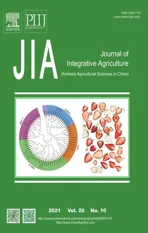Does nitrogen application rate affect the moisture content of corn grains?
2021-08-12ZHANGYuanmengXUEJunZHAlJuanZHANGGuoqiangZHANGWanxuWANGKeruMlNGBoHOUPengXlERuizhiLlUChaoweiLlShaokun
ZHANG Yuan-meng ,XUE Jun ,ZHAl Juan ,ZHANG Guo-qiang ,ZHANG Wan-xu,WANG Ke-ru,MlNG Bo,HOU Peng,XlE Rui-zhi,LlU Chao-weiLl Shao-kun
1 Key Laboratory of Oasis Eco-Agriculture,Xinjiang Production and Construction Corps/Agricultural College,Shihezi University,Shihezi 832000,P.R.China
2 Institute of Crop Sciences,Chinese Academy of Agricultural Sciences/Key Laboratory of Crop Physiology and Ecology,Ministry of Agriculture and Rural Affairs,Beijing 100081,P.R.China
Abstract Nitrogen fertilizer application is an important measure to obtain high and stable corn yield,and the moisture content of corn grains is an important factor affecting the quality of mechanical grain harvesting.In this study,four different nitrogen fertilizer treatments from 0 to 450 kg ha–1 pure nitrogen were set for a planting density of 12.0×104 plants ha–1 in 2017 and 2018,and 18 different nitrogen fertilizer treatments from 0 to 765 kg ha–1 pure nitrogen were set for planting densities of 7.5×104 and 12.0×104 plants ha–1 in 2019,to investigate the effect of nitrogen application rate on the moisture content of corn grains.Under each treatment,the growth of corn,leaf area index (LAI) of green leaves,grain moisture content,and grain dehydration rate were measured.The results showed that,as nitrogen application increased from 0 to 765 kg ha–1,the silking stage was delayed by about 1 day,the maturity stage was delayed by about 1–2 days,and the number of physiologically mature green leaves and LAI increased.At and after physiological maturity,the extreme difference in grain moisture content between different nitrogen application rates was 1.9–4.0%.As the amount of nitrogen application increased,the corn grain dehydration rate after physiological maturity decreased,but it did not reach statistical significance between nitrogen application rate and grain dehydration rate.No significant correlation was observed between LAI at physiological maturity and grain dehydration rate after physiological maturity.In short,nitrogen application affected the grain moisture content of corn at and after physiological maturity,however,the difference in grain moisture content among different nitrogen application rates was small.These results suggest that the effect of nitrogen application on the moisture content of corn grains should not be considered in agricultural production.
Keywords:nitrogen,corn,grain moisture content,leaf area index,physiological maturity
1.lntroduction
In China,corn harvesting is increasingly being performed by mechanical means (Liet al.2017).The high breakage rate which is caused by excessively high grain moisture content during mechanical harvesting is a key factor affecting the quality of grain harvesting and thus limits the promotion of grain harvesting technology (Brookinget al.1990;Chaiet al.2017;Liet al.2018a).Additionally,the moisture content of grains also has a great impact on their drying,storage,transportation,and processing.High grain moisture content often causes economic losses to corn growers and operators,can easily lead to grain mildew,and affects corn quality (Wanget al.2017b).
The grain moisture content of corn is affected by many factors,including genotype,environment and cultivation practices.There has been found to be a significant difference in grain moisture content among different corn varieties (Dutta 1986;Liuet al.2013;Wanget al.2016;Liet al.2017b,2018).In cultivars which reach physiological maturity earlier,the grains dry at a faster rate before physiological maturity,whereas in cultivars which take longer to reach physiological maturity,the grains dry at a slower rate before physiological maturity (Liet al.2012;Wanet al.2018;Jiaet al.2019).In terms of environmental factors,grain dehydration before physiological maturity is affected by average temperature,average wind speed and field evaporation,among which field evaporation contributes the most and temperature and wind speed play an indirect role due to their controlling effects on evaporation;meanwhile,grain dehydration after physiological maturity is directly affected by temperature and relative humidity,with the latter playing a slightly more important role than the former(Gaoet al.2018).Under the shading treatment of corn,the moisture content of grains at physiological maturity tends to increase with increasing shading degree (Yanget al.2019).Additionally,the choice of sowing date,which changes the light and temperature conditions of the corn growth period,affects the growth period and therefore the grain moisture content of corn (Liet al.2017a).Moreover,there has been found to be a significant positive correlation between grain moisture content and the moisture content of bracts and cobs (Minget al.2018).Furthermore,as planting density increases,the grain moisture content at harvest decreases (Bauer and Carter 1986;Vyn and Moes 1988;Widdicombe and Thelen 2002).Moreover,the larger the amount of irrigation application,the higher the grain moisture content during the standing period in the field after physiological maturity (Wanget al.2020).The above research shows that corn variety is an important factor in determining grain dehydration rate and the growing environment as well affects grain dehydration.Cultivation practices affect the dehydration rate of corn grains by affecting the internal physiological changes and external environmental condition.
Nitrogen is an essential nutrient for plants.When corn lacks nitrogen,plant growth is stunted and additionally chlorophyll synthesis is affected,which causes the leaves to wither in the early growth stage,leads to serious light leakage loss in the later growth stage,and results in yield loss (Liuet al.2009;Seyyed 2012).Meanwhile,when nitrogen supply is sufficient,the photosynthetic rate of leaves increases and the functional period of leaves is prolonged,which has a positive effect on grain filling and yield (Xueet al.2010;Timlinet al.2014).However,excessive nitrogen fertilizer application slows down crop growth.At the same time,excessive nitrogen application causes environmental pollution (Mann 1999;Wang 1999;Giles 2005).Recent research showed that nitrogen application rate of 360 kg ha–1pure nitrogen at a planting density of 12.0×104plants ha–1obtained the highest grain yield (21.5–21.6 t ha−1)and economic return and relatively higher nitrogen partial factor productivity and nitrogen agronomic efficiency among various nitrogen fertilizer treatments (Zhanget al.2020).However,the effects of nitrogen application rate on the moisture content and dehydration rate of corn grains are not clear.Therefore,in this study,different nitrogen fertilizer treatments were set up in an experimental field in Qitai,Xinjiang,China,from 2017 to 2019.The effect of different nitrogen fertilizer treatments was assessed by measuring the number of green leaves,the leaf area index(LAI) of green leaves,and the grain moisture content of corn before and after physiological maturity.Additionally,the effects of grain moisture content in the grain growth period on the relationship between LAI,grain moisture content,and grain dehydration rate in the late growth stage of corn were investigated.The research results provide a theoretical basis and technical support for the development and promotion of high-yield mechanical grain harvesting technology.
2.Materials and methods
2.1.Overview of experimental site
The experiments were carried out in the experimental demonstration base of the Institute of Crop Sciences,Chinese Academy of Agricultural Sciences in Qitai,Xinjiang(43°50´N,89°46´E;1 020 m a.s.l.),between 2017 and 2019.Taking a 10-year average (2009–2019) for the growing season (April–October),the average rainfall is 158.6 mm,the average sunshine duration is 2 500–2 800 h,the average temperature is ≥10°C,the accumulated temperature is 3 499.5°C,and the frost-free period is 181.6 d.The native soil is sandy loam.The average soil nutrient contents for the growing season over the three experimental years (2017,2018 and 2019) are shown in Table 1.
2.2.Experimental design
In 2017 and 2018,Xianyu 335 (XY335),a widely-planted corn cultivar in China,was planted at a planting density of 12.0×104plants ha–1and four nitrogen fertilizer rates were set,namely 0 kg ha–1(N0),270,360 and 450 kg ha–1of pure nitrogen (N270,N360 and N450,respectively).N360 is the N application rate used by local farmers.In 2019,XY335 and Denghai 618 (DH618) promoted among local farmers due to their high yield potential of 22.5 t ha–1(Liuet al.2017),were planted at planting densities of 7.5×104and 12.0×104plants ha–1.The former density is adopted by local farmers (Minget al.2017),and the latter one was proved to produce the highest grain yield (Liuet al.2017).In 2019,a more detailed experimental design was carried out to investigate the relationship between nitrogen application rate and grain yield,and further determine the optimum nitrogen application rate in different plant densities and grain levels.In order to maximize the utilization of light radiation and thermal resources,18 nitrogen fertilizer treatments,from 0 to 765 kg ha–1pure nitrogen,were set,with equal increments of 45 kg ha–1.Each treatment was named according to the nitrogen ferlizer rate,i.e.,a treatment of 765 kg ha–1was abbreviated as N765.Additionally,the grain moisture content after physiological maturity was measured in detail.
Each fertilization treatment was set with three repetitions,and a 0.5-m buffer zone was set between the plots to prevent fertilizer movement.All the treatments were applied using an integrated watering and fertilization system under film drip irrigation.The nitrogen application equipment included a water meter and a differential pressure fertilizer tank in order to precisely control the quantity of water and fertilizer application.The irrigation quota was 540 mm per growing season.Nitrogen fertilizer was urea (46% N).Treatment N0 had no nitrogen application.For the other three nitrogen treatments,before sowing,36 kg ha–1N,108 kg ha–1P2O5and 37.5 kg ha–1K2O were applied as seed fertilizer.An additional topdressing without seed fertilizer was applied in equal proportions at the 9th leaf collar (V9),12th leaf collar(V12),silk (R1),blister (R2),and milk (R3) stages by drip irrigation (Table 2).

Table 1 Average soil nutrient conditions in the experimental fields for 2017–2019

Table 2 Application rates of nitrogen fertilizer in the field
For all years,plants were seeded in alternating wide–narrow row patterns ((70+40) cm).Each plot had dimensions of 20 m×3.3 m (area=66 m2) and contained 18 rows.Artificial seeding was carried out on 21,22 and 20 April in 2017,2018 and 2019,respectively.Within 24 h after sowing,the emergence rate and uniformity of seedlings were improved by using dripping water.Plant growth regulator (DA-6 Ethephon,China Agrotech) was sprayed at 600 mL ha–1in the 6th leaf collar (V6)–8th leaf collar (V8) stages to prevent lodging,and weeds and diseases were strictly controlled in the field during the whole growth period.
2.3.Recording of each growth period
The silking stage and physiological maturity stage of corn were recorded.A silk length of female ears of 2–3 cm was used to judge silking.Physiological maturity was recorded when ≥50% of the kernels in the central portion of at least 50% of 10 randomly selected ears of each cultivar from multiple replications showed the presence of a black layer at the base of the kernel (Menget al.2007).
2.4.Assessment of green leaf quantity and green leaf area
During the physiological maturity stage of corn,five representative plants were selected from each plot,and the following were measured for each plant:number of green leaves,length and maximum width of green leaves,leaf area (LA) of green leaves,and LAI of green leaves.The LA and LAI were calculated as follows:
LA=Leaf length×Leaf width×0.75
LAI=Leaf area per plant×Number of plants per unit of land area/Land area
2.5.Grain moisture content and dehydration rate
In 2017 and 2018,before silking,200 representative plants with consistent growth and no pests or diseases were selected and bagged in each treatment.In order to ensure that the sampled ears had a similar pollination date,the paper bag was removed 3 d after silking.On the measurement dates,five ears were selected for unified pollination.In each ear,100 grains were removed from the middle of the ear.These grains were first weighed to determine their fresh weight (g) and weighed again after being dried to a constant weight at 80°C to determine their dry weight (g),and then their moisture content (%) was calculated based on these two different weights using the equation below.The sampling intervals were 7 and 5 d in 2017 and 2018,respectively.If precipitation occurred during sampling,the sampling interval was postponed for 1 d.
Moisture content (%)=(Fresh weight–Dry weight)/Fresh weight×100
In 2019,after the physiological maturity of corn (3 October),every 5–7 days,10 consecutive spikes from the same growth position were selected in each test plot,and two spikes were manually threshed.Then,a PM-8188 portable grain moisture meter (PM8188,Kett Electric Laboratory,Tokyo,Japan) was used to determine the grain moisture content of grains obtained from the threshing,and each treatment was repeated five times.The sampling dates were 3 October,10 October,17 October,and 22 October.Then,the average dehydration rate (% d–1) after physiological maturity was calculated based on the first and last measurements of grain moisture content (KW1 (%) and KW2 (%),respectively) and the number of days between the two measurements,as shown below:
Grain dehydration rate (% d–1)=(KW1–KW2)/Days
2.6.Statistical analysis
The data were analyzed by ANOVA using the SPSS 21.0 Software (IBM,Armonk,NY,USA).The relationships between nitrogen application rate and grain moisture content and dehydration rate after physiological maturity were determined using Pearson correlation analysis.The correlation results were plotted using the Sigmaplot 12.5 Software (Systat Software Inc.,San Jose,CA,USA).
3.Results
3.1.Growth period
As the amount of nitrogen application increased,the silking stage and physiological maturity stage of corn occurred later.In 2017 and 2018,the amount of nitrogen application had no effect on the silking period of XY335 (Table 3);compared with the N0 treatment,the physiological maturity period was delayed by 1 d under the N270 treatment and by 2 d each under N360 and N450.In 2019,under both planting densities,the silking stage of DH618 was delayed by 1 d under N270–N765 compared with that under N0–N225 (Table 4).In the same year,the amount of nitrogen application had no effect on the silking period of XY335.For XY335,the silking period was delayed by 1 d at the density of 12.0×104plants ha–1compared with that at the density of 7.5×104plants ha–1.In 2019,under N765 as compared to under N0,the physiological maturity period of DH618 was delayed by 2 and 1 d at planting densities of 7.5×104and 12.0×104plants ha–1,respectively,and the physiological maturity period of XY335 was delayed by 1 d at both planting densities.

Table 3 Dates of silking and physiological maturity for corn cultivar Xianyu 335 (XY335) under different nitrogen fertilization amounts in 2017 and 2018 (planting density:12.0×104 plants ha–1)

Table 4 Dates of silking and physiological maturity for corn cultivars Xianyu 335 (XY335) and Denghai 618 (DH618) under different nitrogen fertilization amounts and planting densities in 2019
3.2.Green leaf quantity and leaf area
With increasing nitrogen application,the number of green leaves in the physiologically mature stage of corn increased(Fig.1).In 2017 (i.e.,for XY335),the number of green leaves in the physiologically mature stage was 6 under N0,while the number was 7 under N270,N360 and N450.In 2018 (i.e.,for XY335),the number of green leaves in the physiologically mature stage was 4 under N0,while the number was 5 under N270,N360 and N450.In 2019,for DH618,when the amount of nitrogen application increased from 0 to 765 kg ha–1,the number of green leaves in the physiologically mature stage increased from 4 to 9,while for XY335 the number increased from 4 to 11.In the same year,when the planting density increased from 7.5×104to 12.0×104plants ha–1,the average number of green leaves of the 18 nitrogen fertilizer treatments decreased by 0.4and 1.0 at the physiologically mature stage of DH618 and XY335,respectively.
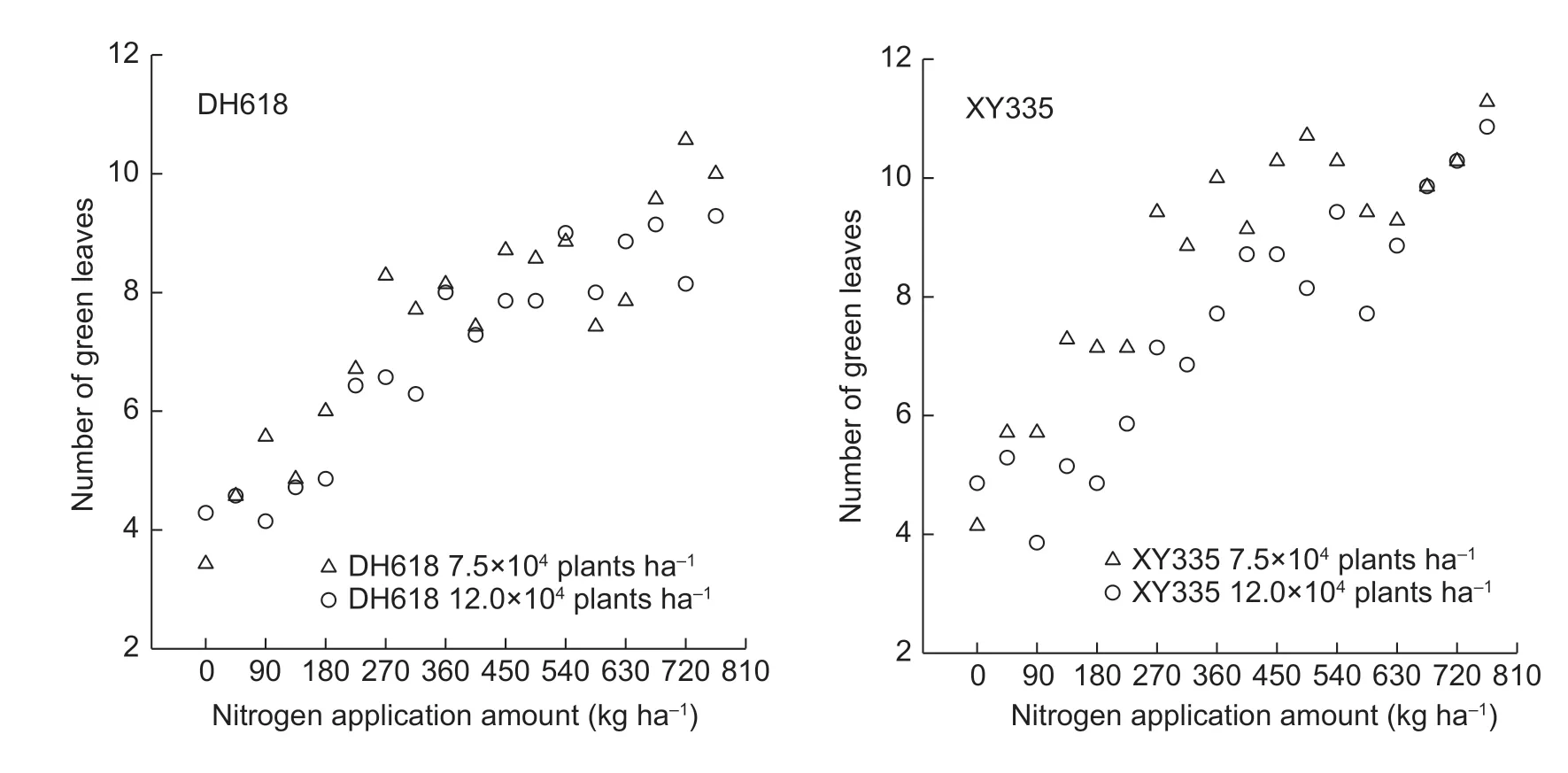
Fig.1 Relationship between nitrogen fertilization amount and the number of green leaves at physiological maturity for the Xianyu 335(XY335) and Denghai 618 (DH618) corn cultivars in 2019.
The LAI of corn at the physiological maturity stage increased with increasing nitrogen application (Fig.2).In 2017 and 2018 (i.e.,for XY335),the LAI was significantly lower under N0 than under the other three nitrogen application treatments.There was no significant difference in LAI between N360 and N450,however,the LAI under both treatments was significantly higher than that under N270.In 2019,for DH618,the LAI increased continuously when the nitrogen application rate was increased from 0 to 315 kg ha–1,however,the change stopped when the nitrogen application amount exceeded 315 kg ha–1.When the planting density of XY335 was 7.5×104plants ha–1,the LAI increased as nitrogen application rate increased from 0 to 315 kg ha–1,but it did not change appreciably under higher fertilization amounts.On the other hand,when the planting density of XY335 was 12.0×104plants ha–1,the LAI increased as the nitrogen application rate increased from 0 to 405 kg ha–1,and then did not change appreciably under higher fertilization amounts.
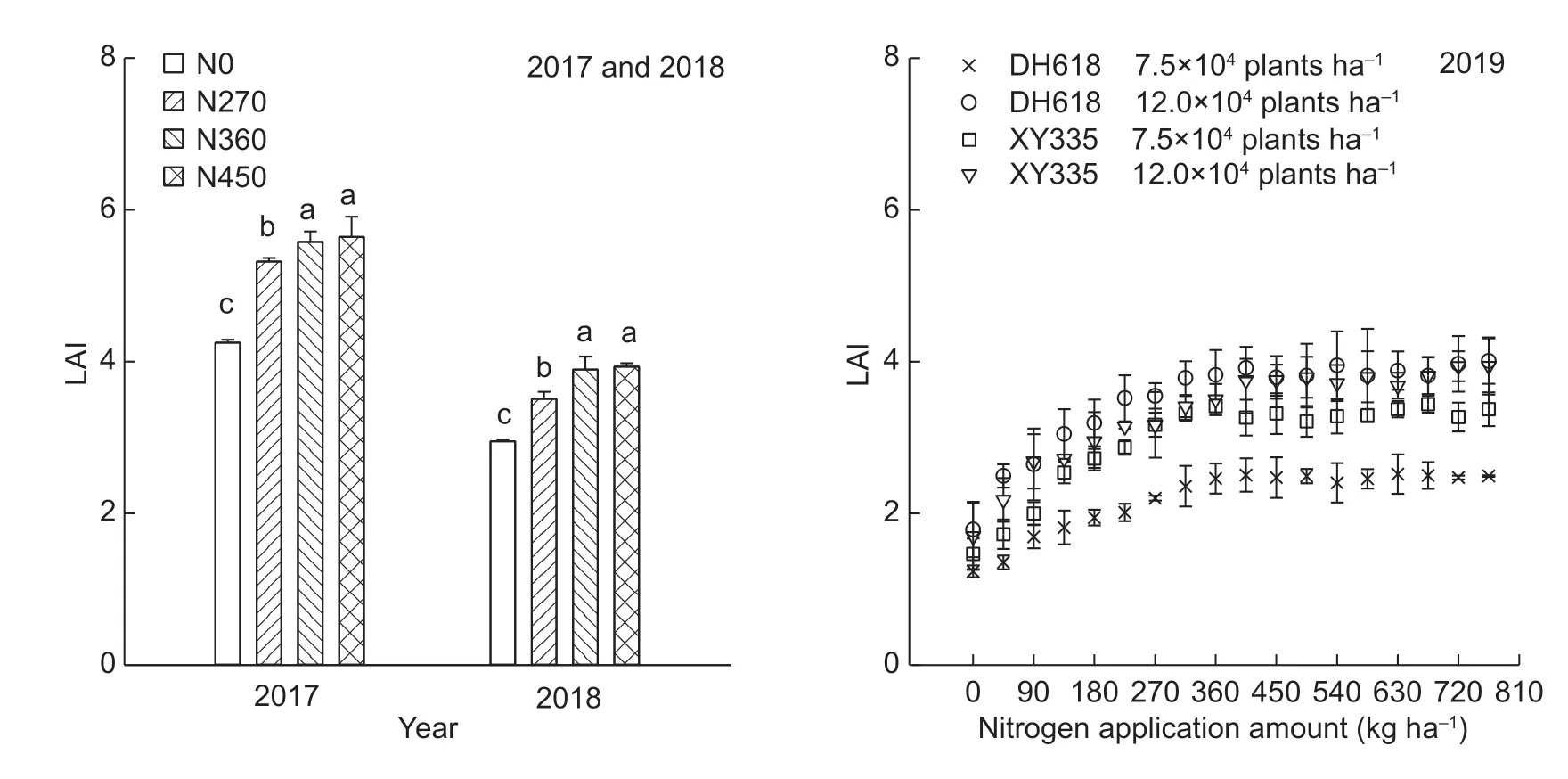
Fig.2 Effect of nitrogen application rate on the leaf area index (LAI) of the two corn cultivars at maturity.N0,N270,N360,and N450,nitrogen fertilizations of 0,270,360,and 450 kg ha–1,respectively.DH618,Denghai 618;XY335,Xianyu 335.Bars mean SD (n=5).The different lowercase letters indicate significance at the P<0.05 probability level.
3.3.Grain moisture content
With the progression of the growth period,the moisture content of corn grains gradually decreased (Fig.3).In 2017 (i.e.,for XY335),there was no significant difference in grain moisture content among the four nitrogen treatments in each sampling period;however,in 2018 (i.e.,for XY335),there was a significant difference among the four nitrogen treatments in the three sampling periods before and after physiological maturity.The extreme difference values(difference between the maximum and minimum values) of grain moisture content among the four nitrogen treatments on 28 September,6 October and 15 October only were 2.6,3.1 and 2.2%,respectively.
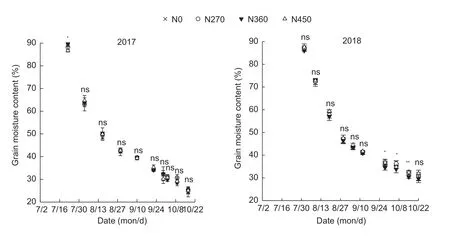
Fig.3 Changes in corn grain moisture content under different nitrogen application rates in 2017 and 2018.N0,N270,N360,and N450,nitrogen fertilizations of 0,270,360,and 450 kg ha–1,respectively.Bars mean SD (n=5).* and ** denote significance at the P<0.05 and P<0.01 probability levels,respectively,according to analysis of variance;ns,not significant according to analysis of variance.
In 2019,the amount of nitrogen application had no significant effect on the grain moisture content of DH618 at a planting density of 7.5×104plants ha–1in the four measurement periods (Fig.4);however,when the planting density was 12.0×104plants ha–1,there was a significant positive correlation between N application and grain moisture content on 3 October and 10 October,and the extreme differences of the 18 nitrogen fertilizer treatments on these two sampling dates were 2.8 and 1.9%,respectively.In the same year,when the planting density of XY335 was 7.5×104plants ha–1,nitrogen application rate was significantly positively correlated with grain moisture content on 17 October and 22 October,and the extreme differences of the 18 nitrogen fertilizer treatments on these two sampling dates were 3.0 and 4.0%,respectively;meanwhile,when the planting density was 12.0×104plants ha–1,nitrogen application rate was significantly positively correlated with grain moisture content on 10 October.The extreme difference of the 18 nitrogen fertilizer treatments on this sampling date was 4.0%.

Fig.4 Effect of nitrogen application amount on corn grain moisture content at different sampling dates in 2019.The horizontal lines in the figures indicate the average grain moisture content under all nitrogen application rates for each sampling date.r denotes the correlation coefficient between nitrogen application amount and corn grain moisture content.DH618,Denghai 618;XY335,Xianyu 335.Bars mean SD (n=5).* and **,significance at the P<0.05 and P<0.01 probability levels,respectively,according to correlation analysis;ns,not significant according to correlation analysis.
3.4.The average grain dehydration rate after physiological maturity
In 2017 and 2018,as the amount of nitrogen application increased,the dehydration rate of XY335 gradually decreased after physiological maturity (Fig.5).When nitrogen application rate increased from 0 to 450 kg ha–1,the average rate of grain dehydration decreased from 0.45 to 0.25% d–1in 2017 and from 0.41 to 0.15% d–1in 2018;however,the correlation coefficients between nitrogen application rate and grain average dehydration rate were not significant in either year.In 2019,the amount of nitrogen application had no significant effect on the dehydration rate of grains for either DH618 or XY335 at either planting density.
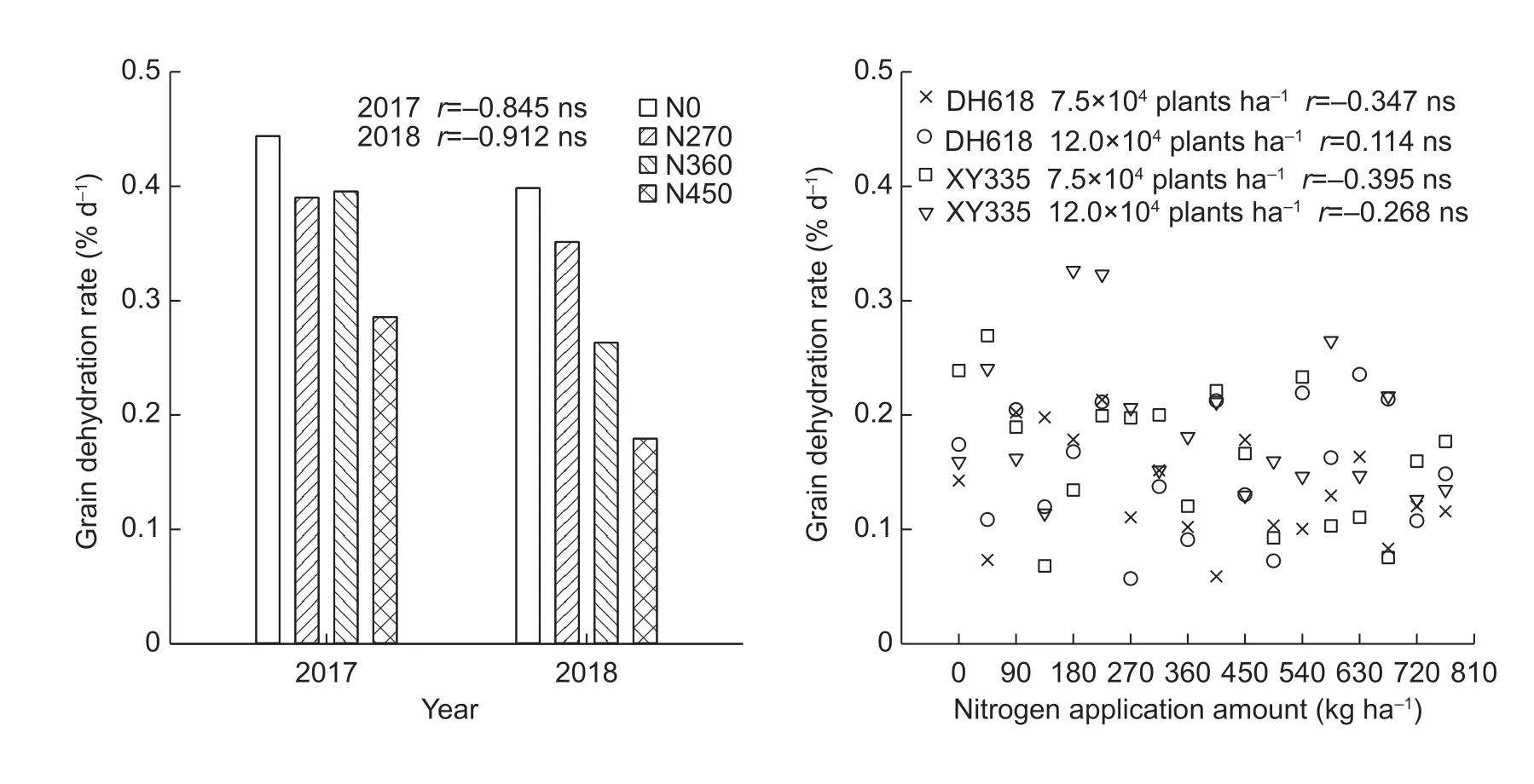
Fig.5 Effect of nitrogen application amount on grain average dehydration rate after physiological maturity.Abbreviations following the format“NX”refer to nitrogen application rates of X kg ha–1,i.e.,N0 refers to no nitrogen fertilization,N270 refers to nitrogen fertilization of 270 kg ha–1,etc.DH618,Denghai 618;XY335,Xianyu 335.r,the correlation coefficient between nitrogen application amount and corn grain moisture content.* and **,significances at the P<0.05 and P<0.01 probability levels,respectively,according to correlation analysis;ns,not significant according to correlation analysis.
3.5.Relationship between green leaf area,grain moisture content and dehydration rate
The relationship between the corn LAI and the grain moisture content at the physiological maturity stage,and the grain dehydration rate after physiological maturity under different nitrogen application rates and planting densities in 2019(Fig.6).The results showed that,for XY335,the grain moisture content at physiological maturity increased significantly with increasing LAI at physiological maturity;for every 1% increase of LAI,grain moisture content increased by 0.43%.However,for DH618,the LAI at physiological maturity had no significant effect on grain moisture content.Furthermore,for DH618 and XY335,the LAI at physiological maturity had no significant effect on the rate of grain dehydration after physiological maturity.
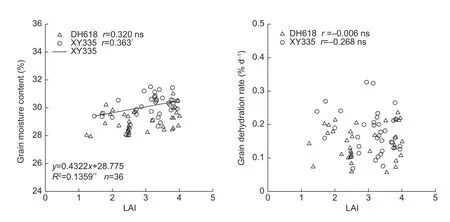
Fig.6 Relationship between leaf area index (LAI) and grain moisture content at physiological maturity,and the grain dehydration rate after physiological maturity.DH618,Denghai 618;XY335,Xianyu 335.r,the correlation coefficient between nitrogen application amount and corn grain moisture content.*,significance at the P<0.05 probability level according to correlation analysis;ns,no significance according to correlation analysis.
4.Discussion
Changes in corn grain filling and grain moisture content can be divided into two stages:the first stage from the blister stage (R1) to the end of the linear filling period(dent stage,R5),and the second stage after the end of the linear filling (Gambinet al.2007;Liet al.2018).In the first stage,the moisture content declines rapidly,mostly due to the rapid accumulation of dry matter (Liet al.2018).After grain maturity,the dominant factor in reducing grain moisture content is the continued loss of grain moisture(Gambinet al.2007).The drying of corn after physiological maturity is mainly affected by meteorological conditions(Shaw and Lomis 1950;Hallauer and Russell 1961).Liet al.(2018) found no significant correlation between the total grain dehydration rate and filling rate before and after physiological maturity for different corn varieties.Nitrogen fertilizer has been shown to affect corn grain yield by affecting the grain filling rate and filling time.Under nitrogen stress,the grain-filling rate of corn is low,the maximum filling rate is increased and the number of days of active filling is decreased (Peasleeet al.1977;Liuet al.2010;Penget al.2015).Additionally,it has been shown that increasing the amount of nitrogen application can increase the grain-filling rate and extend the grain-filling time (Liuet al.2011).This study investigated the grain moisture content of corn before physiological maturity under four nitrogen application rates in 2017 and 2018.The results showed that,in 2017,there were no significant differences in grain moisture content between the four nitrogen fertilization rates before physiological maturity.However,in 2018,there was a significant difference in grain moisture content between the four nitrogen fertilizer treatments at 6–8 d (28 September)before physiological maturity and at 0–2 d (06 October) after physiological maturity;however,the grain moisture content did not show a regular change with changing nitrogen application amount.The extreme differences of moisture content among the four nitrogen fertilizer treatments on 28 September and 6 October were only 2.6 and 3.1%,respectively.The results showed that different nitrogen application amounts had little effect on the grain moisture content of corn before physiological maturity.
After the physiological maturity of corn,the grain stops filling and the grain dehydration is controlled by a physical process.Grain dehydration is affected by ventilation and light transmission conditions (Hickset al.1976;Gaoet al.2018).Previously,corn was defoliated during the physiological maturity period to study the effect of ventilation and light transmission on the dehydration rate and moisture content of the seeds after physiological maturity.The results showed that there was no significant difference in grain moisture content after 15 d of removing 1/2 leaf and removing all leaves compared with the control without removing leaves.This shows that the number of green leaves after physiological maturity has no significant effect on the corn dehydration rate (Troyer and Ambrose 1971;Hickset al.1976).This study found that,with increasing nitrogen application,the number of green leaves and the LAI at the physiological maturity stage of corn both increased.In 2017,there was no significant difference in grain moisture content between the four nitrogen fertilizer treatments after physiological maturity.In 2018,there was a significant difference in grain moisture content between the four nitrogen fertilizer treatments between days 9 and 11,however,the extreme difference was only 2.2%.Additionally,in 2019,it was found that there was a significantly positive correlation between the amount of nitrogen application (18 treatments)and the grain moisture content after physiological maturity for some sampling periods.The extreme difference of grain moisture content among the 18 nitrogen fertilizer treatments was 1.9–4.0%.Further analysis showed that there was no significant correlation between the nitrogen application rate and the rate of grain dehydration after physiological maturity or between the LAI at physiological maturity and the grain dehydration rate after physiological maturity.In 2019,for XY335,the LAI at physiological maturity was positively correlated with grain moisture content.The variation of grain moisture content with LAI was small;for every 1% increase in LAI,grain moisture content increased by only 0.43%.This showed that,after the physiological maturity of corn,canopy LAI had no significant effect on grain dehydration rate and moisture content.
Kernel water loss of corn was related with their water content,water potential,osmotic potential,and turgor.During grain filling of corn kernels,the water potential,osmotic potential and turgor maintain stability (Westgate and Boyer 1986),and they were not affected by the change of cultivars,plant densities and external environment (Borraset al.2003).In this study,the grain-filling rate and extended grain-filling time of kernels were affected by nitrogen fertilizer rate;however,the grain water status was not affected by nitrogen fertilizer rate during grain filling.Grain water status(water potential,osmotic potential and turgor pressure) was independent of whole-plant water status,particularly leaf status (Ouattaret al.1987).Therefore,the kernel moisture content was not affected by green leaves under different amounts of nitrogen application.
Grain hardness is an important factor affecting the quality of mechanical harvesting (Wanget al.2017b).The hardness of corn grains is affected by moisture content and internal chemical composition.As the moisture content decreases,the grain hardness decreases (Guoet al.2020).Under the same grain moisture content,the protein content of corn grain was significantly positively correlated with the grain hardness (Gerdeet al.2016).Previous studies have found that an increase in nitrogen fertilizer rate can increase the proportion of keratin endosperm in corn grain,which affects the hardness of the grain (Gunasekaran and Paulsen 1985;Maddonni and Otefui 2006).This study mainly analyzed the degree of influence of nitrogen application on the moisture content of corn grain.The degree of the influence of nitrogen application on the crushing sensitivity of corn grain will be discussed in future research.
The results of this study suggest that the amount of nitrogen fertilizer application affects the moisture content of corn grains,but the absolute value of the moisture content of corn grains changes little across different nitrogen treatments.The range of nitrogen application in corn production in China is 260–270 kg ha–1(Sunet al.2011;Caoet al.2012;Zanget al.2017).In the present study,it was found that the extreme difference of grain moisture content between two varieties and two densities was 0.1–2.5% in the range of 260–270 kg ha–1in 3 yr.This range of extreme difference is very small,indicating that grain crushing sensitivity will not cause a large difference (Guoet al.2020).Therefore,the results of this study indicate that it is not necessary to consider the effects of nitrogen application on the moisture content and fragmentation of corn kernels in agricultural production.
In this study,integrated watering and fertilization technology through drip irrigation postponed nitrogen application during the filling stage and extended the functional period of the blade.However,it is difficult for the traditional flooding irrigation mode in China to achieve nitrogen fertilizer topdressing in the late growth stage,and farmers typically apply excessive fertilizers and water before the seeding and V6 stages and do not fertilize during the filling stage.Excessive application of fertilizers and water at early growth stages and under application of both at late growth stages lead to the overgrowth of corn in the early growth stages and increase the leaf senescence rate in the late growth stage.In the future,it is necessary to further study the effect of nitrogen application rate on grain moisture content under traditional flooding irrigation mode and for different corn cultivars.
5.Conclusion
The silking stage of corn was delayed by about 1 d and the physiological maturity period was delayed by 1–2 days,as nitrogen application rate increased from 0–765 kg ha–1.Additionally,nitrogen application was shown to affect the grain moisture content of corn at and after physiological maturity.However,the difference in grain moisture content between different nitrogen application rates was small.Therefore,the effect of nitrogen application on the moisture content of corn grains should not be considered in agricultural production.
Acknowledgements
This study was supported by the National Key Research and Development Program of China (2016YFD0300605),the China Agriculture Research System of MOF and MARA(CARS-02-25) and the Agricultural Science and Technology Innovation Project of the Chinese Academy of Agricultural Sciences.
Declaration of competing interest
The authors declare that they have no conflict of interest.
杂志排行
Journal of Integrative Agriculture的其它文章
- Assessing the impact of non-governmental organization’s extension programs on sustainable cocoa production and household income in Ghana
- Triple bottom-line consideration of sustainable plant disease management:From economic,sociological and ecological perspectives
- A rice geranylgeranyl reductase is essential for chloroplast development
- lmpacts of climate change on drought risk of winter wheat in the North China Plain
- Rapid determination of leaf water content for monitoring waterlogging in winter wheat based on hyperspectral parameters
- Effects of drought stress on root morphology and spatial distribution of soybean and adzuki bean
